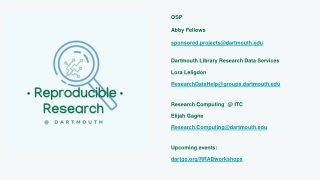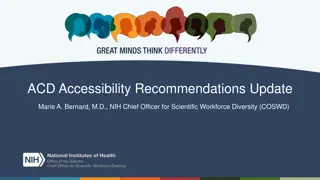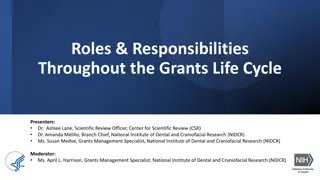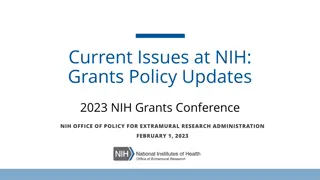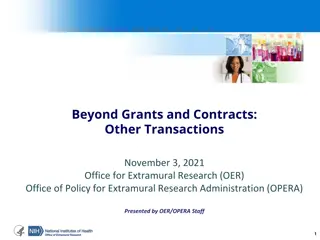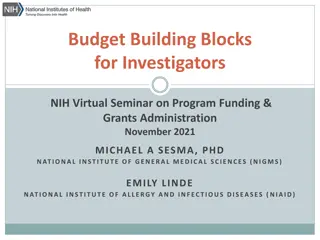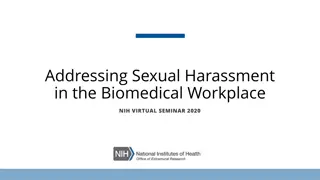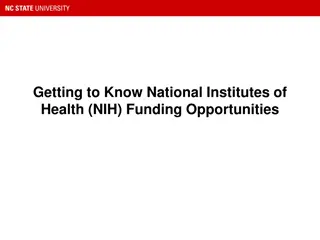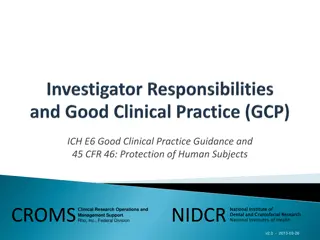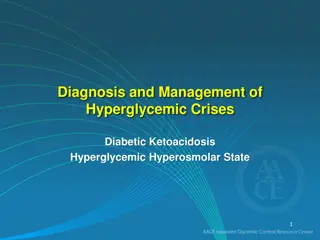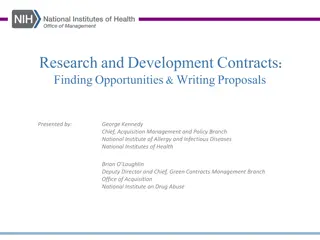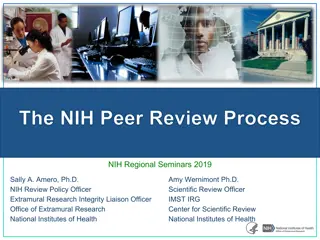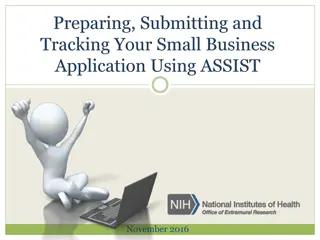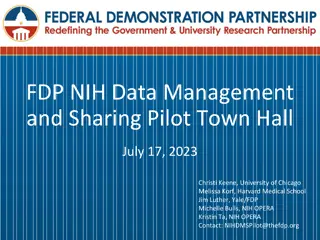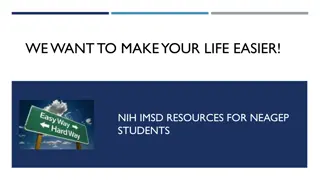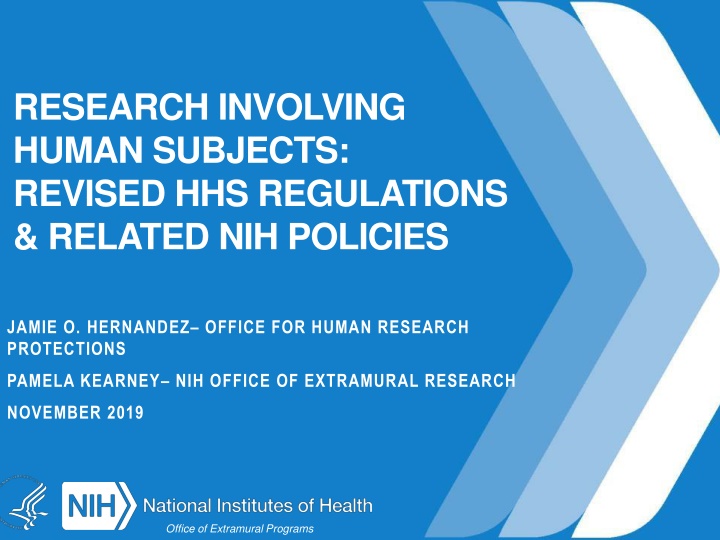
Revised HHS Regulations for Human Research Protections
Explore the role of OHRP and HHS regulations in human subject research, learn about changes to the Common Rule, understand NIH implementation of these changes, and discover updated NIH policies related to human subjects research.
Download Presentation

Please find below an Image/Link to download the presentation.
The content on the website is provided AS IS for your information and personal use only. It may not be sold, licensed, or shared on other websites without obtaining consent from the author. If you encounter any issues during the download, it is possible that the publisher has removed the file from their server.
You are allowed to download the files provided on this website for personal or commercial use, subject to the condition that they are used lawfully. All files are the property of their respective owners.
The content on the website is provided AS IS for your information and personal use only. It may not be sold, licensed, or shared on other websites without obtaining consent from the author.
E N D
Presentation Transcript
RESEARCH INVOLVING HUMAN SUBJECTS: REVISED HHS REGULATIONS & RELATED NIH POLICIES JAMIE O. HERNANDEZ OFFICE FOR HUMAN RESEARCH PROTECTIONS PAMELA KEARNEY NIH OFFICE OF EXTRAMURAL RESEARCH NOVEMBER 2019 Office of Extramural Programs
LEARNING OBJECTIVES Describe the role of OHRP and the HHS regulations for human research protections Explain some of the changes to the Common Rule and know how to make basic determinations on whether a study needs IRB review Recognize how NIH will implement the Common Rule changes Identify updated NIH policies related to human subjects research. 2 Office of Extramural Programs
OHRPs Role in Human Research Protections OHRP holds the regulatory authority on the HHS Protection of Human Subjects regulations, 45 CFR 46 Subpart A is referred to the Common Rule Revisions to the Common Rule were published on 1/19/17, with a general implementation date of 1/19/18. After subsequent delays, general compliance date: 1/21/2019 OHRP has a distinct role from these HHS agencies: FDA regulates clinical investigations involving drugs, devices, and biologics NIH conducts and supports research that must comply with OHRP regulations 3
Overview of the Human Subjects Review Process for NIH Grant Applications NIH Peer Review (contact NIH program officer for assistance) IRB Process(contact IRB office or OHRP@hhs.gov for assistance) Submit study to IRB according to institutional policies IRB reviews non-exempt human subjects research according to 45 CFR 46 If approval criteria are met, IRB approves non-exempt human subject research Peer review for appropriateness, adequacy of human subjects protections described Follow NIH policies and instructions to submit application NIH ready to release grant award Institution must provide certification of IRB review and approval for non-exempt HSR to NIH before the award can be released Start Here
Three Pillars of Human Subjects Protections Under the Common Rule 1. Institutional Assurance of Compliance (Federalwide assurance FWA) Documents institution s commitment to protecting the rights and welfare of research subjects 2. Institutional Review Boards (IRB) Review Oversees and reviews research by an independent committee with diverse knowledge and perspectives Reviews and approves non-exempt human subjects research according to criteria laid out in the regulations 3. Informed Consent Respects research subjects autonomy to participate or not Helps protect subjects interests 5
Protecting Research Subjects: A Shared Responsibility Research institutions IRBs Investigators Sponsors Regulators 6
DOES MY STUDY REQUIRE IRB REVIEW? APPLYING THE BASICS OF THE REGULATIONS 7
Quick Reminder About When the Regulations Apply Non-exempt human subjects research conducted or supported by HHS Non-exempt human subject research covered by the Assurance of Compliance ( check the box ) 8
When Do the Regulations Apply? To determine if your project is non-exempt human subjects research Ask these questions in this order: 1) Does the activity involve research? 2) Does the research involve human subjects? 3) Is the research with human subjects exempt? 9
Determining When an Activity is Non-Exempt, Human Subjects Research (and therefore the Common Rule applies) 1 2 3 Does it involve human subjects? Is it Is it exempt? Yes Yes No research? Yes No or Study requires to IRB review No (may require limited IRB review for certain exemptions) Deemed not to be research Green text indicates sections that have changed with the 2018 revisions to the Common Rule. 10
1: Does the Activity Involve Research? Research refers to a systematic investigation, including research development, testing, and evaluation, designed to develop or contribute to generalizable knowledge Revised Common Rule Citation moved from 46.102(d) to 46.102(l) in the revised Common Rule New: 4 sets of activities specifically deemed not to be research 11
Activities Deemed Not to be Research in the Revised Common Rule Scholarly and journalistic activities that focus directly on the specific individuals about whom the information is collected 1. Government functions with separately mandated protections Public health surveillance activities limited to those necessary to identify, monitor, assess, or investigate conditions of public health importance Collection and analysis of materials for criminal justice purposes Authorized operational activities for national security purposes 2. 3. 4. 12
Determining Whether the Revised Common Rule Applies 2 1 Does it involve human subjects? Is it Yes research? No or Deemed not to be research 13
2: Does it Involve Human Subjects? Human subject: a living individual about whom an investigator conducting research (1) Obtains information or biospecimens through intervention or interaction with the individual, and uses, studies, or analyzes the information or biospecimens; or (2) Obtains, uses, studies, analyzes, or generates identifiable private information or identifiable biospecimens 46.102(e)(1) Revised Common Rule:no substantive changes in interpretation, only language clarifyications 14
Research with Biospecimens or Private Information that is Not Human Subjects Research IF: Biospecimens or private information were NOT collected specifically for the research study in question (i.e.; there are no interactions or interventions with human subjects) 1) AND investigator(s) cannot readily ascertain identity of the individual(s) to whom data/specimens pertain 2) THEN: Research is NOT human subjects research. Coded Unidetifiable 15
Determining Whether the Revised Common Rule Applies 2 3 1 Does it involve human subjects? Is it Is it exempt? Yes Yes research? No or No Deemed not to be research 16
Summary of Changes to Exemptions Revised Common Rule Pre-2018 Rule (Current) Restrictions added Educational practices Educational tests, surveys, interviews, observation of public behavior Research on public officials Research on existing data Public benefit service Taste and food evaluations 1. 2. Expanded * Removed and replaced * 3. 4. 5. 6. Expanded old and added new Expanded with changes No change New Exemption # 7 * New Exemption # 8 * * New limited IRB review to make certain determinations as a condition of exemption 17
Revised Common Rule Exemption 1: Restrictions Added Research on normal educational practices in established or commonly accepted educational settings New: normal educational practices that are not likely to adversely impact: Students opportunity to learn required educational content, or Assessment of educators who provide instruction 46.104(d)(1) 18
Revised Common Rule Exemption 2: Expanded Research that only includes interactions involving educational tests, surveys, interviews, and observations of public behavior when Information recorded cannot be readily linked back to subjects, or Any information disclosure would not place subjects at risk of harm, or Identifiable information recorded, with limited IRB review for privacy and confidentiality protection under 46.111(a)(7) i. ii. iii. 46.104(d)(2) 19
Revised Common Rule Exemption 3: New (Replacement) Research involving benign behavioral interventions with adults who prospectively agree, when information collection is limited to verbal or written (including data entry) or audiovisual recording, and: Information recorded cannot be readily linked back to subjects, or Any information disclosure would not place subjects at risk of harm, or Identifiable information recorded, with limited IRB review for privacy and confidentiality protection under 46.111(a)(7) A. B. C. 46.104(d)(3) 20
Revised Common Rule Exemption 3, cont. Benign behavioral interventions These are brief in duration, harmless, painless, not physically invasive, not likely to have a significant adverse lasting impact on the subjects, AND investigator has no reason to think the subjects will find the interventions offensive or embarrassing Includes authorized deception research 46.104(d)(3)(ii)-(iii) 21
Revised Common Rule Exemption 4: Expanded Secondaryresearch use of identifiable private information or identifiable biospecimens (materials no longer need to be existing ), if: Identifiable private information or identifiable biospecimens are publically available, OR Information, which may include information about biospecimens, is recorded by the investigator in such a manner that the identity of the human subjects cannot be readily ascertained directly or through identifiers linked to the subjects, the investigator does not contact the subjects or re-identify subjects, OR i. ii. Cont . 22
Exemption 4 (cont.) ( ) secondary research use of identifiable private information or identifiable biospecimens, if: Investigator s use is regulated under HIPAA as health care operations, research, or public health OR iii. iv. Research is conducted by, or on behalf of, a Federal agency using data collected or generated by the government for non-research purposes, and the information is protected by federal privacy standards 46.104(d)(4) 23
Revised Common Rule Exemption 5: Expanded Public benefit and service programs research and demonstration projects Expanded to apply to such Federally-supported research (no longer limited to Federally-conducted research) Added requirement that Federal agency publish a list of projects covered by this exemption prior to commencing the research 46.104(d)(5) 24
Revised Common Rule Exemption 6: No Change Taste and food quality evaluation and consumer acceptance studies 46.104(d)(6) 25
Revised Common Rule: NEWExemptions 7 and 8 Two new exemptions applicable only to secondary research: Exemption 7: Storage or maintenance of identifiable private information or identifiable biospecimens for secondary research Exemption 8: Secondaryresearch using identifiable private information or identifiable biospecimens Both require: Broad consent Limited IRB review 46.104(d)(7) and (8) 26
NEW Allowing the Use of Broad Consent for Secondary Research Optional: An alternative to traditional informed consent or waiver of informed consent If: Identifiable information or identifiable biospecimens were collected with broad consent Then, exemptions 7 and 8 may apply respectively to: The storage and maintenance of this material (after a limited IRB review) Future secondaryresearch use of this material (after a limited IRB review) Broad consent must include a defined set of elements that cannot be omitted or altered 46.116(d)-(f) 27
NEW Limited IRB Reviews Required for exemptions 2(iii), 3(i)(C), 7, and 8 in the revised Common Rule Exemptions 2(iii) and 3(i)(C) review: For privacy and confidentiality protection under _.111(a)(7) Exemptions 7 and 8 review: For safeguards related to privacy and confidentiality protection, and broad consent Expedited review can be used One time only, no continuing review required 28
Determining Whether the Revised Common Rule Applies 2 3 1 Does it involve human subjects? Is it Is it exempt? Yes Yes No research? Yes No or Study requires to IRB review No (be aware of limited IRB review for certain exemptions)* Deemed not to be research Green text indicates sections that have changed with the 2018 revisions to the Common Rule. 29
Please refer to the text of the revised Common Rule available on OHRP s website (hhs.gov/ohrp) for a complete and accurate description of the regulatory requirements
? ? ? ? ? ? ? Questions About the Revised Common Rule? OHRP has developed resources about the revised Common Rule at: www.hhs.gov/ohrp Submit your questions to OHRP@hhs.gov Stayed connected! Join our listserv at: https://www.hhs.gov/ohrp/news/sign-up-for- announcements/index.html 31
NIH IMPLEMENTATION OF THE REVISED COMMON RULE PAMELA KEARNEY, M.D. DIRECTOR, DIVISION OF HUMAN SUBJECTS RESEARCH NATIONAL INSTITUTES OF HEALTH NOVEMBER 2019 OEP-HS@MAIL.NIH.GOV Office of Extramural Programs
LEARNING OBJECTIVES Describe the role of OHRP and the HHS regulations on human research protections Explain some of the changes to the Common Rule and know how to make basic determinations on whether a study needs IRB review Recognize how NIH is implementing the Common Rule changes Identify updated NIH policies related to human subjects research. 33 Office of Extramural Programs
NIH IMPLEMENTATION OF REVISED COMMON RULE- BASICS No NIH requirement for IRBs to review grant applications and contract proposals Posting clinical trial consent forms Changes to exemptions Forms, Instructions & Reviewer Guidance Updated No NIH requirement for certain continuing reviews See Guide Notice: NOT-OD-19-050 Published January 2, 2019 Office of Extramural Programs 34
REMOVAL OF REQUIREMENT FOR IRB REVIEW OF APPLICATION/PROPOSAL HOWEVER! IRB certification confirming that all protocols described in the application have been reviewed and approved by the IRB is still required In NO cases will human subjects research be initiated prior to receipt of the certification that the research has been reviewed and approved by the IRB See Guide Notice: NOT-OD-19-055 Published January 11, 2019 Office of Extramural Programs 35
POSTING CLINICAL TRIAL CONSENT FORMS Recipients conducting a clinical trial must submit an IRB-approved version of a consent form used to enroll participants on a public federal website: ClinicalTrials.gov (English Language Consent forms only) Regulations.gov Docket ID: HHS-OPHS-2018-0021 (maintain a copy of the Regulations.gov receipt and tracking number) NIH Guide Notice: NOT-OD-19-110 Published May 17, 2019 Office of Extramural Programs 36
CHANGES TO EXEMPTIONS Applications submitted for due dates on or after January 25, 2019 are able to select exemptions 7&8 Decision tool available at https://grants.nih.gov/policy/hum ansubjects/hs-decision.htm Office of Extramural Programs 37
CONTINUING REVIEW No NIH requirement for annual review if not required by Common Rule unless otherwise specified in Funding Opportunity Announcements Examples: Studies eligible for expedited review, studies that have completed interventions NOTE: Institutions/IRBs may have additional requirements Office of Extramural Programs 38
SINGLE IRB NIH sIRB policy and Common Rule sIRB mandate ARE NOT THE SAME! All studies are expected to abide by the provisions of 45CFR46.114 regarding cooperative research, if applicable. Office of Extramural Programs 39
NIH sIRB POLICY APPLIES TO Domestic sites of multi-site studies DOES NOT APPLY TO Exclusions: Same/shared protocol Foreign sites Career development (K), institutional training (T), and fellowship awards (F) Exceptions All non-exempt human subjects; not just clinical trials All new and re-competing applications/proposals When Federal, State, Tribal, local requirements require local review Tribal regulations/policies given specific consideration in order to ensure that the importance of their role is recognized Time-limited Exception ancillary studies to ongoing parent studies without single IRB Other Exceptions may be considered: When there is a compelling justification Do not require NIH approval Grants and R&D Contracts Effective Dates: Competing grant applications Application due dates on/after January 25, 2018 Contract proposals Require NIH approval Solicitations issued on/after January 25, 2018 Guide Notice: http://grants.nih.gov/grants/guide/notice- files/NOT-OD-16-094.html Office of Extramural Programs 40
SINGLE IRB TIPS AND RESOURCES Reliance agreement samples: OHRP s IRB Authorization Agreement http://www.hhs.gov/ohrp/register-irbs-and-obtain-fwas/forms/irb- authorization-agreement/index.html. NIH s National Center for Advancing Translational Sciences (NCATS) Streamlined, Multi-site, Accelerated Resource for Trials (SMART) IRB Reliance Platform Resources https://ncats.nih.gov/expertise/clinical/smartirb NOT-OD-16-109 Scenarios to Illustrate the Use of Direct and Indirect Costs for Single IRB Review under the NIH Policy on the Use of a Single IRB for Multi-site Research Frequently Asked Questions https://grants.nih.gov/grants/policy/faq_single_IRB_policy_research.htm Office of Extramural Programs 41
NIH HUMAN SUBJECTS RESEARCH WEBSITE https://grants.nih.gov/policy/humansubjects.htm 42 Office of Extramural Programs 42

